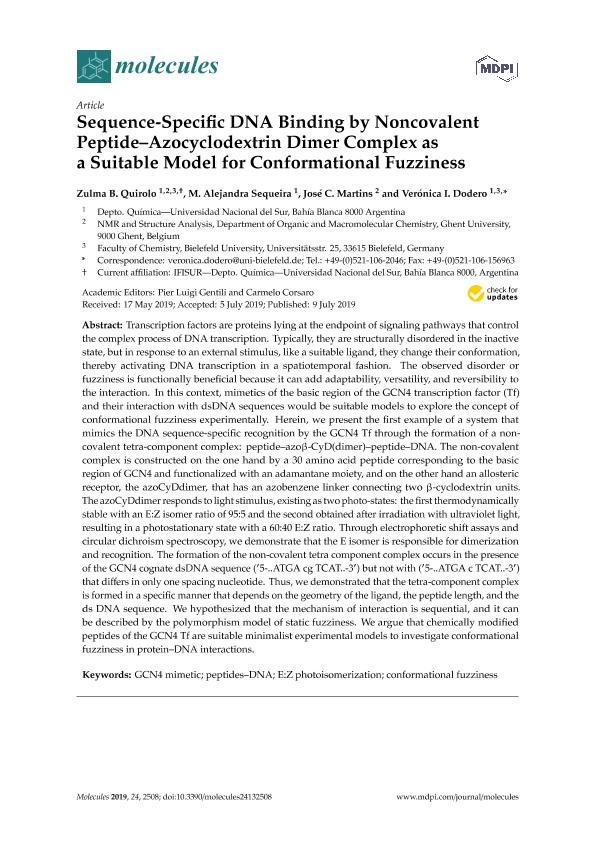Mostrar el registro sencillo del ítem
dc.contributor.author
Quirolo, Zulma Beatriz

dc.contributor.author
Sequeira, María Alejandra

dc.contributor.author
Martins, José C.

dc.contributor.author
Dodero, Veronica Isabel

dc.date.available
2020-08-10T19:07:09Z
dc.date.issued
2019-07-09
dc.identifier.citation
Quirolo, Zulma Beatriz; Sequeira, María Alejandra; Martins, José C.; Dodero, Veronica Isabel; Sequence-specific DNA binding by noncovalent peptide–azocyclodextrin dimer complex as a suitable model for conformational fuzziness; Molecular Diversity Preservation International; Molecules; 24; 13; 9-7-2019; 2508-2528
dc.identifier.issn
1420-3049
dc.identifier.uri
http://hdl.handle.net/11336/111340
dc.description.abstract
Transcription factors are proteins lying at the endpoint of signaling pathways that control the complex process of DNA transcription. Typically, they are structurally disordered in the inactive state, but in response to an external stimulus, like a suitable ligand, they change their conformation, thereby activating DNA transcription in a spatiotemporal fashion. The observed disorder or fuzziness is functionally beneficial because it can add adaptability, versatility, and reversibility to the interaction. In this context, mimetics of the basic region of the GCN4 transcription factor (Tf) and their interaction with dsDNA sequences would be suitable models to explore the concept of conformational fuzziness experimentally. Herein, we present the first example of a system that mimics the DNA sequence-specific recognition by the GCN4 Tf through the formation of a non- covalent tetra-component complex: peptide–azoβ-CyD(dimer)–peptide–DNA. The non-covalent complex is constructed on the one hand by a 30 amino acid peptide corresponding to the basic region of GCN4 and functionalized with an adamantane moiety, and on the other hand an allosteric receptor, the azoCyDdimer, that has an azobenzene linker connecting two β-cyclodextrin units. The azoCyDdimer responds to light stimulus, existing as two photo-states: the first thermodynamically stable with an E:Z isomer ratio of 95:5 and the second obtained after irradiation with ultraviolet light, resulting in a photostationary state with a 60:40 E:Z ratio. Through electrophoretic shift assays and circular dichroism spectroscopy, we demonstrate that the E isomer is responsible for dimerization and recognition. The formation of the non-covalent tetra component complex occurs in the presence of the GCN4 cognate dsDNA sequence (′5-..ATGA cg TCAT..-3′) but not with (′5-..ATGA c TCAT..-3′) that differs in only one spacing nucleotide. Thus, we demonstrated that the tetra-component complex is formed in a specific manner that depends on the geometry of the ligand, the peptide length, and the ds DNA sequence. We hypothesized that the mechanism of interaction is sequential, and it can be described by the polymorphism model of static fuzziness. We argue that chemically modified peptides of the GCN4 Tf are suitable minimalist experimental models to investigate conformational fuzziness in protein–DNA interactions.
dc.format
application/pdf
dc.language.iso
eng
dc.publisher
Molecular Diversity Preservation International

dc.rights
info:eu-repo/semantics/openAccess
dc.rights.uri
https://creativecommons.org/licenses/by/2.5/ar/
dc.subject
CONFORMATIONAL FUZZINESS
dc.subject
E:Z PHOTOISOMERIZATION
dc.subject
GCN4 MIMETIC
dc.subject
PEPTIDES–DNA
dc.subject.classification
Química Orgánica

dc.subject.classification
Ciencias Químicas

dc.subject.classification
CIENCIAS NATURALES Y EXACTAS

dc.title
Sequence-specific DNA binding by noncovalent peptide–azocyclodextrin dimer complex as a suitable model for conformational fuzziness
dc.type
info:eu-repo/semantics/article
dc.type
info:ar-repo/semantics/artículo
dc.type
info:eu-repo/semantics/publishedVersion
dc.date.updated
2020-02-26T19:37:09Z
dc.journal.volume
24
dc.journal.number
13
dc.journal.pagination
2508-2528
dc.journal.pais
Suiza

dc.journal.ciudad
Basilea
dc.description.fil
Fil: Quirolo, Zulma Beatriz. Consejo Nacional de Investigaciones Científicas y Técnicas. Centro Científico Tecnológico Conicet - Bahía Blanca. Instituto de Física del Sur. Universidad Nacional del Sur. Departamento de Física. Instituto de Física del Sur; Argentina
dc.description.fil
Fil: Sequeira, María Alejandra. Universidad Nacional del Sur; Argentina
dc.description.fil
Fil: Martins, José C.. University of Ghent; Bélgica
dc.description.fil
Fil: Dodero, Veronica Isabel. Universitat Bielefeld; Alemania. Universidad Nacional del Sur. Departamento de Química; Argentina
dc.journal.title
Molecules

dc.relation.alternativeid
info:eu-repo/semantics/altIdentifier/doi/http://dx.doi.org/10.3390/molecules24132508
dc.relation.alternativeid
info:eu-repo/semantics/altIdentifier/url/https://www.mdpi.com/1420-3049/24/13/2508
Archivos asociados
